mobile View, to the German Version tap the flag
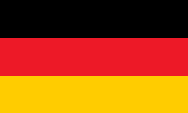

- Republic of Costa Rica
- democratic presidial republic
- own name: Républica de Costa Rica
• Flags
• Historical Flags
• Meaning/Origin of the Flag
• Coat of Arms
• Meaning/Origin of the Coat of Arms
• Aircraft Roundel
• Map
• Numbers and Facts
• History
• Origin of the Country's Name
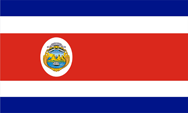
National, state and naval flag,
ratio = 3:5,
Source, by: Wikipedia (D)





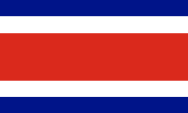
Merchant flag,
ratio = 2:3,
Source, by: Wikipedia (D)






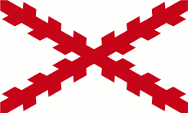
1538–1717,
Flag of the Kingdom of New Spain,
Source, by: Wikipedia (ES)




1717–1785,
Flag of the Vice-Kingdom of New Granada,
Source, by: Wikipedia (EN)



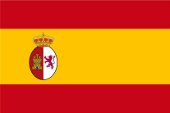
1785–1821,
Flag of the Vice-Kingdom of New Spain,
Source, by: World Statesmen



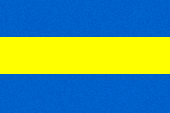
1821–1822,
National flag,
Source, by: World Statesmen



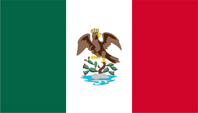
1822–1823,
Flag of the Mexican Empire,
Source, by: Wikipedia (EN)




05.10.1823–04.03.1824,
National flag,
Source, by: Wikipedia (DE)



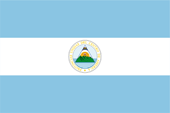
04.03.1824–02.11.1824,
National flag of the United Provinces of Central America,
Source, by: Wikipedia (DE)



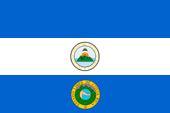
02.11.1824–22.11.1824,
Flag of the Central American Confederation added by the emblem of Costa Rica,
Source, by: Wikipedia (DE)
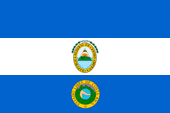
22.11.1824–15.11.1840,
Flag of the Central American Confederation added by the emblem of Costa Rica,
Source, by: Wikipedia (DE)
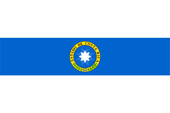
21.04.1840–20.04.1842,
National flag,
Source, by: Wikipedia (DE)



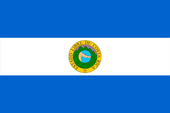
Sept. 1842–12.11.1848,
National flag,
Source, by: Wikipedia (DE)



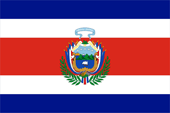
29.09.1848–27.11.1906,
National flag,
Source, by: Wikipedia (D),
HansenBCN [Public domain], via Wikimedia Commons




The flag of Costa Rica shows since 1848 five horizontally stripes in the colours blue, white, red, white and blue in the proportion 1:1:2:1:1. The today's flag of Costa Rica was introduced in the year 1906 on occasion of the adoption of a new coat of arms. The new coat of arms became appreciably minimized and positioned in a white oval within the red middle stripe near the flagstaff. On 21st of October in 1964 the coat of arms was slightly changed by increasing the number of stars in the coat of arms from five to seven. The colours blue and red are defined, among others, in Pantone PMS, as blue = Pantone Reflex Blue and red = Pantone 485. In Costa Rica is it private persons forbidden by law to use the national flag. There is only permitted to use pennants and ribbons in the colours of the country. Nevertheless is frequently in use the merchant flag. It carrys no coat of arms. In the year 1821 Costa Rica became independent from Spain. The first own flag was a horizontally threefold striped flag in the colours blue, yellow and blue. Probably should be symbolized with this design the position of the "rich coast" (= Costa Rica) between the oceans. Already in 1823 was adoped a new flag, though Costa Rica belonged to the Empire of Mexico. It showed a white bunting with a six-pointed red star in the middle. Costa Rica was since 1824 a member of the Central American Confederation and used since March its flag, but from November was in use as a characteristic an own coat of arms below the coat of arms of the federation. As Costa Rica in the year 1838 left the federation, nevertheless was maintained the flag of the federation until 1848, except between 1840 and 1842 as there was in use a flag in inversion of colours (→ Central American Confederation). As in 1848 the King of France Louis-Philippe of Orléans was unseated and whole Europe fell in a revolutiuonar frenzy, the wife of the then President of Costa Rica also advised to add the flag of the country by a central, broad, red middle stripe, because the flag should appear in the colours of France. This new flag was adoped on the 29th of September in 1848, completed by the new designed coat of arms.
Today's flags of the states of Central America all date back to the flag of the Central American Federation. This feature is particularly pointed out in every single flag of each Central American country, and in Nicaragua it is even said that the flag of the Federation is in principle continued until today. But where is the reason for all these blue tones which vary from country to country, sometimes lighter, sometimes darker? The problem is that flags as historical finds are seen with the modern eye, and quickly is a certain colour fixed – Keyword "light blue" – completely ignoring the fact that the reason for the light blue is very likely to be due to washing out and bleaching, an attribute known for Indigo dye (woad) until today, intented and appropriately exploited. It gets even worse if the light blue is supposed to have been a very specific one. Different dyeing plants were used for dyeing textiles. However, the blue had a different colour depending on which dyeing plant was used. These could be: woad (for a medium blue), later indigo, elderberries (for red-violet), delphinium and red cabbage (for turquoise), alkanna and bluewood (for violet). Therefore it is absolutely obvious that it would come to very different shades, especially for the colour blue. It is clear that, before the age of industrialisation with its chemical capabilities, few standards could be achieved, and it is easy to understand why so many colour-shades appeared in blue. To make matters worse, there were hardly any possibilities to set the colours for a long time, so that after a short time washing out and fading was apparent. The light blue of the historic flags must therefore first be seen as a side effect which is to be accepted, and has been accepted, and not as an intent. The heraldry knew no light blue or dark blue. Blue was blue, no matter what it looked like. Although the colour tones for today's flags may be precisely defined, this is not true for historical flags. Therefore, a uniform "middle blue" was used here for the representation of the blue tone on a historical flag.
Source:
Die Welt der Flaggen,
Flaggen Wappen Hymnen,
Flaggen und Coat of arms of the Welt,
Wikipedia (D),
Wikipedia (EN),
Volker Preuß

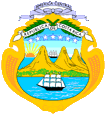
Coat of arms of Costa Rica,
Source: Corel Draw 4

The today's coat of arms of Costa Rica was introduced in 1848 and changed anytimes, so in 1906 and finally in 1964. It shows three volcanos on a narrow isthmus between two oceans, on whom rides ever one sailing ship. In the heaven seven stars in a line. The volcanos symbolize the landmass-bridge between North and South America, the water surfaces stand for Atlantic and Pacific. The seven stars stand for the seven provinces of Costa Rica. Until 1964 there were only five star, which however symbolized the membering states of the Central American Confederation. The coat of arms of Costa Rica remembers far for the coat of arms of the Central American Confederation.
Source:
Flaggen Wappen Hymnen

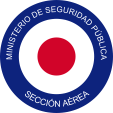
1964–1994,
Aircraft Roundel,
Source, by: Wikipedia (EN)

Location:
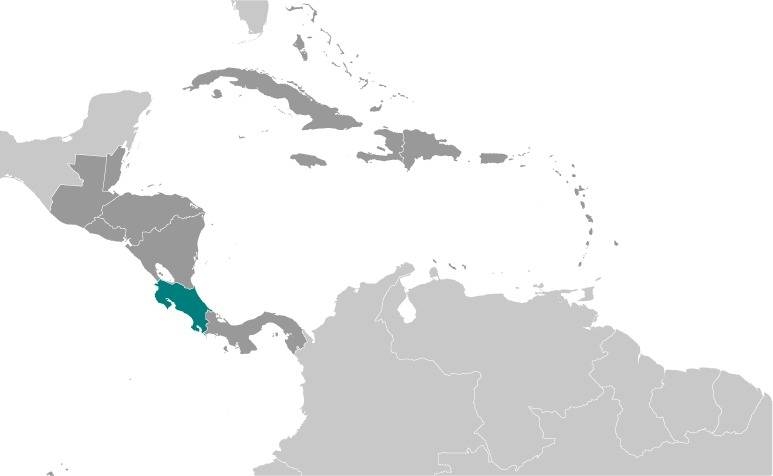
Source: CIA World Factbook
Map of the country:
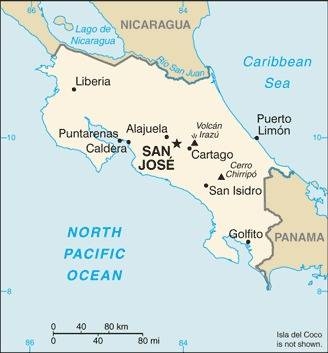
Source: CIA World Factbook

Area: 19.730 square miles
Inhabitants: 5.100.000 (2020), thereof 94% Europeans and Mestizos, 3% Afro-Americans and Mulattos, 1% Chinese, 1% Indians
Religions: 52% Roman Catholic, 22% Protestant, 17% Non-Religious
Density of Population: 258 inh./sq.mi.
Capital: San José, 339.588 inh. (2006)
official Language: Spanish
other Languages: Creole English
Currency: 1 Costa Rican Colón (CRC) = 100 Céntimos
Time Zone: GMT – 6 h
Source:
Wikipedia (D)

1502 · discovery of the eastern coast of the today's Costa Rica by Christoph Columbus
1522 · discovery of the western coast of the today's Costa Rica by the Spanish seafarer de Avila
1524 · exploration of the country by the Spaniard Juan Vázquez de Coronado, foundation of the first Spanish housing estate, in the afteryears colonization by Spain
1535 · establishment of the Vice Kingdom of New Spain, which affiliates whole Central America (and therewith as a partial province even the today's Costa Rica) as "General Capitanate of Guatemala"
1560 · the exploration and colonization of the country by Spain is completed
1731 · foundation of San José
29.10.1821 · proclamation of the independence
Januar 1822 · Costa Rica joines the Empire of Mexico
1823 · after the overthrow of the Mexican emperor gets the connexion to Mexico untied, and the states of the former General Capitanate of Guatemala combine to the "United Provinces of Central America" (Central American Confederation)
1838 · Costa Rica leaves the Central American Confederation
1843–1847 · unstable governments, frequent changes
1848 · new constitution
1917 · military coup d'état of the Minister of Defence Tinoco
1919 · US-American military intervention, counter coup d'état
1944 · termination of the border's problems with the neighbouring countries
1948 · disputed electional result, civil war, government under José Ferrer, new constitution
1949 · abolition of the army by José Ferrer, transformation into a 7.500 man potent militia, added by police forces
1983 · Costa Rica proclaims a strict status of neutrality
Juli 1998 · quarrels with Nicaragua near the border-river San Juan
Source:
Atlas zur Geschichte,
Wikipedia (D),
Discovery '97,
Weltgeschichte

The name Costa Rica is from Spanish origin and means "rich coast". The name was awarded the eastern coast of this country by Christoph Columbus, because he found here in the year 1502 natives with abundant golden jewelries. This name was taken over in the times for the whole behind situated country.
Source: Handbuch der geographischen Namen


![]()









































